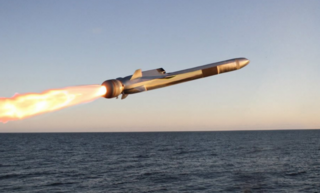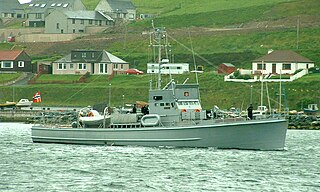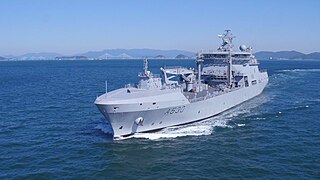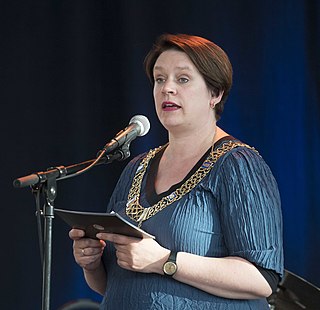Related Research Articles

The Royal Norwegian Navy is the branch of the Norwegian Armed Forces responsible for naval operations of Norway. As of 2008, the Royal Norwegian Navy consists of approximately 3,700 personnel and 70 vessels, including 4 heavy frigates, 6 submarines, 14 patrol boats, 4 minesweepers, 4 minehunters, 1 mine detection vessel, 4 support vessels and 2 training vessels. It also includes the Coast Guard.

The Fridtjof Nansen-class frigates are a class of frigates that are the main surface combatant units of the Royal Norwegian Navy. The ships are named after famous Norwegian explorers, with the lead ship of the class bearing the name of Fridtjof Nansen, the Norwegian scientist, explorer and humanitarian. Five ships were ordered from Spanish shipbuilder Bazan.

Marinejegerkommandoen (MJK) is the maritime/naval special warfare unit of the Norwegian Armed Forces and was established in 1953.

HNoMS Helge Ingstad was a Fridtjof Nansen-class frigate of the Royal Norwegian Navy. The vessel was ordered on 23 June 2000 and constructed by Navantia in Spain. The ship was launched on 23 November 2007 and commissioned on 29 November 2009. Named for Helge Ingstad, a Norwegian explorer, the Fridtjof Nansen class are capable of anti-air, anti-submarine and surface warfare. On 8 November 2018, HNoMS Helge Ingstad was in collision with the tanker Sola TS in Norwegian waters just outside Sture Terminal. Helge Ingstad was severely damaged in the collision and ran aground. On 13 November 2018, the ship sank where she had run aground and became a constructive total loss.
HMS P41 was a Royal Navy U-class submarine built by Vickers-Armstrong. She was transferred to the exiled Royal Norwegian Navy before completion and renamed HNoMS Uredd. She and one of the B-class in 1940 have so far been the only Norwegian submarines to have been sunk.

The Naval Strike Missile (NSM) is an anti-ship and land-attack missile developed by the Norwegian company Kongsberg Defence & Aerospace (KDA).

The Nordkapp class is a Norwegian Coast Guard ship class built in the 1980s, and is used for rescue, fishery inspection, research purposes and general EEZ patrol in Norwegian waters. It is a class of ships purpose-built for the Norwegian Coast Guard with a secondary role as wartime naval escorts. The Norwegian Coast Guard is a part of the Royal Norwegian Navy, and has some police authority.

Anne-Grete Hjelle Strøm-Erichsen is a Norwegian politician for the Labour Party. She served as Minister of Defence from 2005 to 2009 and again from 2012 to 2013. She also served as Minister of Health and Care Services from 2009 to 2012. In local politics, she served as the Mayor of Bergen from 1999 to 2000 and its first Chief Commissioner from 2000 to 2003.
HNoMS Kvikk (P984) was a Royal Norwegian Navy fast patrol boat (FPB) of the Snøgg class which was built in 1970, taken out of service in 1994 and scrapped in 1996. The boat gained a lot of media attention in the so called Kvikk case, due to claims that an abnormally high number of the children of the men who had served on the boat were born with club foot or other congenital disorders.
RS Sjøfareren is the largest lifeboat in use by the Norwegian organization Norwegian Society for Sea Rescue.

Widerøe Flight 933, also known as the Mehamn Accident, was the crash of a de Havilland Canada DHC-6 Twin Otter operated by Norwegian airline Widerøe. The Twin Otter crashed into the Barents Sea off Gamvik, Norway on 11 March 1982 at 13:27, killing all fifteen people on board. The results of the four official investigations were that the accident was caused by structural failure of the vertical stabilizer during clear-air turbulence. A mechanical fault in the elevator control system caused the pilots to lose control of pitch; and either a series of stalls or a high-speed gust of wind caused the aircraft to lose altitude without the ability of the crew to counteract, resulting in the failure of the vertical stabilizer.

HNoMS Hitra is a Royal Norwegian Navy submarine chaser that saw action during World War II. She is named after the Norwegian island of Hitra.

HNoMS Tyr was a mine control vessel used for underwater search and recovery by the Royal Norwegian Navy. It was decommissioned in 2014 and sold to private owners.

Kjersti Toppe is a Norwegian doctor and politician representing the Centre Party. She has served as minister of children and families since 2021, and an MP from Hordaland since 2009.

The HNoMS Hessa was a Royal Norwegian Navy submarine chaser that saw action during World War II. She was named after the Norwegian island of Hessa.

Helge André Njåstad is a Norwegian politician for the Progress Party. He was elected to the Parliament of Norway from Hordaland in 2013 where he serves as the chair of the Standing Committee on Local Government and Public Administration. He was mayor of Austevoll from 2003 to 2013.
Allied Forces South Norway (SONOR) was a NATO command tasked with the defense of Southern Norway. SONOR's area of responsibility included all of Norway with the adjacent sea territory excluding the three northernmost counties of Norway, which were under Allied Forces North Norway.
A Town Betrayed is a 2010 Norwegian documentary about the prelude of the Srebrenica massacre (1995), written and directed by journalists Ola Flyum and David Hebditch and produced by Fenris Films, NRK, among others. It was shown on NRK's Brennpunkt on 26 April 2011 and SVT on 28 August 2011.

HNoMS Maud is a replenishment oiler constructed at Daewoo Shipbuilding & Marine Engineering in South Korea. She was built on behalf of the Norwegian Defense Materials Agency Forsvarsmateriell, for service in the Royal Norwegian Navy.

Marte Mjøs Persen is a Norwegian politician from the Labour Party. She has served as minister of labour and social inclusion since 2022, and minister of petroleum and energy from 2021 to 2022. She served as the mayor of Bergen from 2015 until being elected to the Storting in 2021.
References
- ↑ NTNU universitetsavisa: Kvikk ble frikjent (Norwegian)
- ↑ bt.no: Fikk ingen advarsler (Norwegian)
- ↑ Aftenposten.no: 17 millioner til «Kvikk»-barna
- ↑ Dagbladet.no: «Kvikk»-barn får oftere klumpfot (Norwegian)
- ↑ NRK Hordaland: Lover erstatning til «Kvikk»-ofre (Norwegian)
- ↑ Medical chief at Haakonsvern marine base Jan Helge Halleraker to Forsvarets Forum the 26 March 1997: «Om vi sitter igjen med bevis på at sædceller påvirkes og skades av elektromagnetisk stråling i visse frekvenser, da har vi tatt medisinen ett hakk videre» (Norwegian) (Translated: "If we can prove that sperm cells are affected and damaged by electromagnetic radiation at certain frequencies, then we have taken medicine a step further"
- ↑ NRK Hordaland: Nyttig "Kvikk"-granskning (Norwegian)
- ↑ bt.no: - «Kvikk» burde vært stengt (Norwegian)
- ↑ bt.no: - «Kvikk» burde vært stengt (Norwegian)
- ↑ NRK Hordaland: -Ingen jubel (Norwegian)
- ↑ NRK Hordaland: Feil førte til radarstråling (Norwegian)
- ↑ NRK Hordaland: Stråling kan ha gitt misdannelser (Norwegian)
- ↑ bt.no: En nysgjerrig forsker (Norwegian)
- ↑ NRK Hordaland: Feil førte til radarstråling (Norwegian)
- ↑ NRK Hordaland: Full gjennomgang av Kvikk-saken (Norwegian)
- ↑ Aftenposten.no: 17 millioner til «Kvikk»-barna (Norwegian)
- ↑ NRK Hordaland: Forventar full gransking (Norwegian)
- ↑ bt.no: «Kvikk»-ofre får erstatning (Norwegian)
- ↑ Teknisk Ukeblad: Ingen fasit for Kvikk (Norwegian)